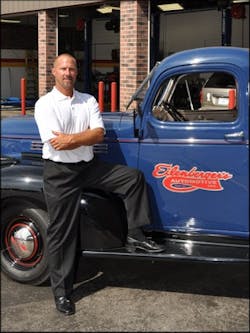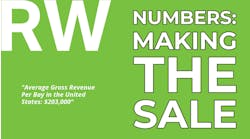Up until a few months ago, Paul Eilenberger showed up for work in jeans and a shop shirt and spent most of his days wrenching on vehicles.
But Eilenberger is not a technician; he’s the owner of Eilenberger’s Automotive, a 10-bay $1.2 million-a-year facility in Overland Park, Kan. As a longtime mechanic who launched his business from scratch 16 years ago, fixing cars is second nature to him. He’s good at it. He hired a staff that’s good at it. That expertise quickly grew the business from its humble three-bay, $300,000-a-year beginnings. But it wasn’t enough.
Eilenberger was so involved with moving vehicles through his shop that he didn’t pause to think about how to optimize his prices, services, labor rate and other important aspects of the business for long-term growth. The shop hit a wall five years ago—revenue reached $1 million, but the shop bobbed in and out of profitability. There was enough income to keep the doors open and nothing more. So Eilenberger sought help from a consultant, and learned to start thinking differently about his role as a manager.
Eilenberger’s Automotive
Location:
Overland Park, Kan.
Owners:
Paul and Larry Eilenberger
Square Footage:
7,500
Employees:
9
Annual Revenue:
$1.2 million
Cars Per Month:
200
Average Repair Order:
$550
“He was used to being a tech and he knew that if he fixed the cars, he got paid,” says industry consultant Cecil Bullard, who helped Eilenberger turn around his shop. “He felt that being a technician in the business was the role that he needed to play because it helped put money in the bank and pay the bills. By focusing on the business itself—improving margin, improving car count, improving the average repair order—he now has all the time and all the money he needs to do what he needs to do in that business, and a much better profit.”
Bullard, CEO of Automofo.com, says many shop operators start out as techs and have a hard time withdrawing from that line of work, but it’s essential if they want their businesses to be sustainable. Eilenberger began working on the transition roughly a year ago, but he wasn’t fully comfortable with putting down the wrench and trading his work shirt for a dress shirt until recently.
Even so, a stronger focus on his business as a whole during the last year has enabled him to build his profit margin to a consistent 15–20 percent. He’s used that cash for new equipment and additional staff—things that were out of reach a few years ago.
Trouble With Change
Eilenberger’s goal right out of junior college was to own his own shop by the time he was 30. With the help of his father, Larry Eilenberger, he achieved that goal by age 27, after only five years of experience as a mechanic.
Paul had the automotive know-how and Larry had the financial resources and some business acumen from his experience in sales for a large engineering company.
—Paul Eilenberger, owner, Eilenberger’s Automotive
“I picked up just enough business knowledge to be really dangerous,” Larry says. “I thought I knew something about business and we got into it and as it turns out, it took a while to figure out that I really didn’t know that much.”
The father and son started out leasing an existing repair shop that was mostly equipped. Truly a family-run business, Larry acted as CEO, his wife handled administrative duties, and Paul managed the shop floor, handling all of the service writing and repairs with one other technician.
As time went on, the shop earned a solid reputation and work volume increased beyond the little store’s capacity. So, after a decade of business, the Eilenbergers moved to their current, larger, location and added staff. Volume continued to grow, along with Paul’s management duties. His parents began transitioning out of the shop, but he was still doing the same thing—fixing cars.
Meanwhile, revenue grew, but profits were minimal—maybe 2 percent during a good month—and sometimes nonexistent. The shop’s labor rate and prices were neglected and outdated. Car volume took precedence over maximizing repair orders. The shop’s staple service was quick, affordable oil changes, which drew customers but slowed progress on larger, more profitable jobs.
Paul recognized that he needed to get a better handle on the shop’s numbers, so he decided to bring on another service writer two years ago, enabling him to step away from that task to focus more on business management. But after a year, he was still convinced that he had to have a hand in repairs, so little changed.
“Seeing that we had made this jump and we were just floating on dollars back and forth, we decided we needed a little assistance in our business, so we hired a business coach,” Paul says. “And he’s basically taken me completely out of the mechanic role to where I’m managing my business now.”
In the Driver’s Seat
Stepping away from repairs was tough for Paul and it required placing more trust in his employees. He transitioned gradually, but found that once he really started digging into his shop’s numbers and evaluating its processes, there was more than enough to keep him occupied.
His first task was to set a goal for profitability. Previously, he focused on growing the shop’s total sales, but paid little attention to what he made off of the bottom line. Consultant Bullard says this is a common mistake and one that leaves shops with little or nothing to invest in the business.
Paul knew that he wanted to start replacing some outdated equipment, such as lifts, and that he wanted to add at least one more mechanic, so he started evaluating the cost of those additions, along with the shop’s annual expenses and what he wanted to achieve in savings—a new concept for the shop. He determined that he would need a profit margin of 15 percent or better to start making the investments he wanted. He set an ambitious goal of 20 percent to give the shop something to strive for and started looking into how the business could achieve it.
The first substantial change he made was to drop the shop’s $19.99 walk-in oil changes, which were done in about 20 minutes as customers waited. Now oil changes cost $34 and come with a thorough vehicle inspection, which takes 45 minutes to an hour. The change caused many of the shop’s regular oil-change customers to stop showing up, but Paul says those individuals never made additional purchases and actually hindered productivity. The shop was busy, but it wasn’t rewarded for all of the hard work.
Now oil-change customers receive a thorough report that includes any repairs that might need to be made. The shop doesn’t push immediate sales of those items, but most customers are appreciative of the service and opt to have the repairs made. And if they don’t, they’ll often remember Eilenberger’s when the problems surface, and they’ll return to the shop.
Eilenberger’s made it a policy to perform the complete inspections, called customer vehicle inspections or CVIs, on all jobs. The change cut the shop’s weekly car count from roughly 100 to about 50, but the average repair order rocketed from $200 to $550.
“Before our little change, we were a repair shop that repaired a customer’s complaint,” Paul says. “Sure, we kept our eyes open if we saw something, but that wasn’t our main objective. … Now, with the CVI, we get a complete picture and that’s how our average repair order is driven up.”
Bullard says successful shops should be able to find between $1,000 and $2,000 of legitimate work on every vehicle and sell at least 60 percent of it. Complete vehicle inspections not only result in extra dollars, they also prevent customers from returning with problems—Eilenberger’s has had zero comebacks since implementing the strategy.
A higher labor rate also contributed to the shop’s repair-order boost. With Bullard’s coaxing, Eilenberger’s increased its labor rate from $85 an hour—where it had been for more than five years—to $96 an hour. Paul and Larry say their loyal customer base didn’t bat an eye at the change, especially since the shop was stepping up its service. This was a surprise to Larry.
“We thought it would run our customers off,” he says. “But you can’t be scared. That’s one thing we learned.”
Today, Eilenberger’s is on pace for a $1.3 million year and is maintaining a profit margin between 15 and 20 percent. Paul recently replaced five of the shop’s lifts and he has started looking for a new technician. Plus, he carried savings over from the previous year for the first time in recent memory.
Now he comes to work in a dress shirt and black pants and leaves the vehicle repairs to his staff. He is focused entirely on working on, rather than in, his business.
“If I was still working as a mechanic or service writing, I don’t know if we would be in the spot we’re in right now,” he says.



